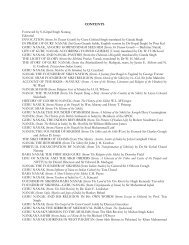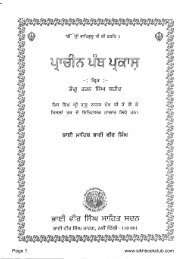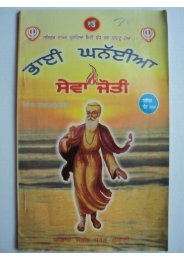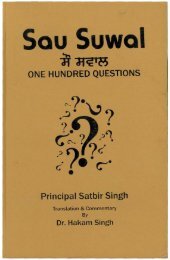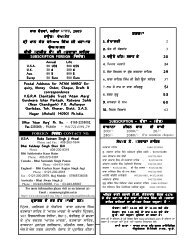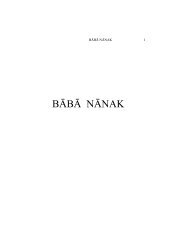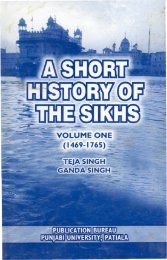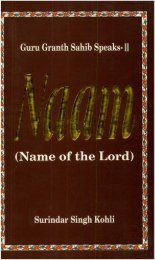Create successful ePaper yourself
Turn your PDF publications into a flip-book with our unique Google optimized e-Paper software.
Sarkar-i-Khalsa because of the debt he owed to the Khalsa and<br />
the Guru whose century-old struggle and vision had catapulted<br />
him to the position of a sovereign ruler of the Punjab. Shah<br />
Mohammed himself takes note of the Sikh identity by using the<br />
word Singh frequently. His laudatory references to the Khalsa<br />
leave no doubt that Khalsa had come to symbolise the Punjabi<br />
pride during his period. His general reference to the existence<br />
of two communites in Punjab Le. Hindu and Muslim in no way<br />
merges the Sikhs within the Hindu social order. We fmd<br />
references by the British chroniclers also wherein Sarkar-i<br />
Khalsa is described as a Hindu state. Such references are casual<br />
and reflect only lack of knowledge about ground realities and<br />
unique position of the Sikhs in the Indian sub-continent. We need<br />
not refer to such things while looking around in search of a<br />
Punjabi identity as compared to Bengali, Tamil, Gujrati or Oriya<br />
identities. The only comparison that one can think of and that<br />
can sustain with the Punjabi-Sikh identity is Maharashtra-Maratha,<br />
Rajasthan-Rajput identities. Here also the presence of the Sikhs<br />
in Punjab as a distinct community, with an independent religious<br />
system of their own in their own right and identification of the<br />
Hindus with their majority co-religionists in the rest of India and<br />
the Muslims with the erstwhile ruling class makes the question<br />
of Punjabi regional identity altogether different and more<br />
complex.<br />
However, the project of rendition ofjangnamah into Hindi<br />
and English undertaken by Mr. P.K. Nijhawan more as a mission,<br />
is unique in another respect also. Shah Mohammed represents<br />
the ethos of post-Ranjit Singh Punjab and the impact of Ranjit<br />
Singh's rule on Punjabi society is well brought out by him in<br />
the jangnamah. No doubt, Shah Mohammed's jangnamah<br />
describes the elan of the masses of the Punjab as a whole, who<br />
had then come to identify themselves with Khalsa-]i-Ke-Bol-Bale.<br />
He looks unto Ranjit Singh and the Khalsa as symbols of Punjabi<br />
glory, condemns traitors like Gulab Singh and also does not<br />
spare the Sikh Sardars like Lehna Singh Majithia, who despite<br />
their capabilities, did not rise to the occasion and preferred to<br />
(9)




